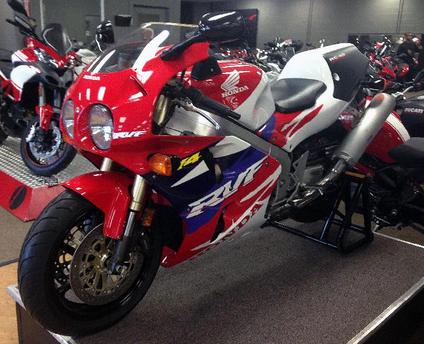
Staff member Kurt Hertel writes a blog with lots of interesting stuff, including historical accounts of some of their collection. Click "Read More" below to read his take on the history of this model, and when you've got a few hours to kill after lunch at work, give the blog a visit:
http://www.faymyers.com/custompage.asp?pg=kurts_corner
Like the RC30, the machine was not that impressive in as-delivered form, especially at the MSRP of $27,000. In U.S. trim, the bike made around 100hp, while snipping a wire freed up another few ponies. European models were rated at 118hp, and the factory race kit brought it up to about 150. When fully developed in its final season of 1999, the best race versions were over 190hp, not bad for a 750. Of course the full HRC race kit cost more than the bike itself, and by the end changed pretty much everything about the bike that could be changed under Superbike rules while remaining race legal (it even came with blueprints for porting ), but when Honda wants to win races, cost is usually no object.
One of Honda’s goals with the RC45 was to allow it to rev higher than the RC30. Toward that end, they used a more oversquare bore/stroke ratio (72mmx46mm versus the RC30’s 70mmx48.6mm) to reduce piston speeds, and reduced friction by relocating the cam drive mechanism (still by gears, of course) to the end of the crankshaft from its central location on the RC30, meaning one less crankshaft bearing and four less camshaft bearings. While still using titanium conrods like the RC30, the RC45’s were lighter and stronger. Low friction materials used on pistons and bores also contributed, as did low-friction rings. Breathing was improved through the use of a reduced valve angle, which allowed for straighter intake ports, while increasing the size of the intake valves by 2 mm. In order to take full advantage of the RC45’s improved breathing, Honda adapted its PGM fuel injection from the NR750 for use on the RC45, incorporating sensors for throttle position, crankshaft position, manifold pressure, camshaft position, air temperature, coolant temperature, barometric pressure, and battery voltage. While such systems are now commonplace, it was exotica of the first order on a motorcycle in 1994. Also adapted from the NR750 was the back-torque limiting clutch.
The chassis dimensions also changed, with a longer wheelbase and longer swingarm than the RC30, along with a revised engine mounting position. Whether the geometry changes were for better or worse is apparently a point of contention, with some riders claiming that the engine’s weight was carried too far forward, and others claiming the opposite. What is clear is that the front-end feel of the RC30 did not immediately translate directly to the RC45. Given the level of racing success that Honda enjoyed with the RC30, simple regression analysis would show that it would be a tough act to follow. In the case of the RC45 though, it took a lot of work to get the bike to where the RC30 was almost immediately after its introduction. The RC45 didn’t win its first World Superbike race until 1996 (ridden by Aaron Slight), and only won one World Superbike championship (John Kocinski), in 1997. It did, however, win two AMA Superbike championships in 1995 (Miguel DuHamel) and 1998 (Ben Bostrom, without winning a race all season), and finished second in ’96 and ’97 (both DuHamel). While numerous bikes have never won either of these championships, Honda is probably the only manufacturer that would see such a record as a failure. After struggling against the 250cc advantage given to V-twins (read Ducati) over four cylinder bikes from the inception of World Superbike competition through 1999, Honda finally decided that since they couldn’t beat them, they would join them, building the RVT1000R, usually called the RC51, a 999cc V-twin that won the championship in 2000 and 2002 (both Colin Edwards). In fact, only 4 750cc 4-cylinder bikes have won the World Superbike championship, and three of those four were won by the RC30 and RC45 (the other was the Kawasaki ZXR750 ridden by Scott Russell in 1993). While the RC51 was very successful on the track and still has a cult following to this day, it was not the technological tour de force that the V-fours were in their day, and I think it unlikely that a Japanese factory will again produce such an exotic and expensive road bike merely to homologate it for racing. One can only hope.
Kurt Hetel
 RSS Feed
RSS Feed